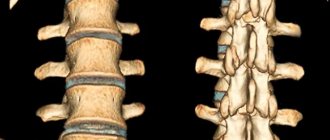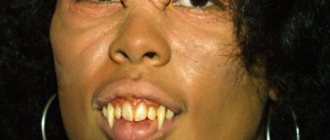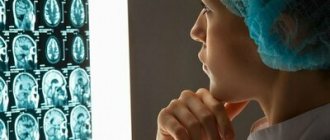Home » Department of Pediatrics » Tay-Sachs disease
GM2 gangliosidosis (Tay-Sachs disease) is a disease with an autosomal recessive pattern of inheritance that affects the central nervous system (spinal cord, brain, and meningeal membranes). During the first six months of life, children develop normally with this disease, but then brain functions begin to suffer, and they often die before the age of 3-4 years.
The incidence rate is about 1 case per 250,000 population.
Classification of Tay-Sachs disease
- Child form : after six months after birth, children experience a continuous deterioration in physical and mental abilities: blindness, deafness, cannot swallow. The muscles atrophy and paralysis occurs. Death occurs before the age of 3-4 years.
- Adolescent form : motor-cognitive problems, problems with swallowing (dysphagia), problems with speech (dysarthria), unsteadiness of gait (ataxia), spasticity develop. Patients die before the age of 15-16 years.
- Adult form : occurs between the ages of 25 and 30 years, characterized by gait disturbances and progressive deterioration of neurological functions. Typical symptoms are: problems with swallowing and speech, unsteadiness of gait, decreased cognitive skills, spasticity, and the onset of schizophrenia in the form of psychosis.
Prevention
Prevention of the disease lies primarily in a well-planned pregnancy. Spouses must undergo genetic testing to identify the defective gene. If such a gene is detected, the decision to conceive remains with the spouses.
Family history
Family history allows the doctor to find out about the presence of sick blood relatives or carriers of the disease among them. This approach allows us to determine the degree of risk for the unborn child.
Blood relatives who will help determine the possibility of manifestation of the disease:
- immediate family, including parents, sisters, brothers and children;
- secondary relatives, including parents' sisters and brothers, nephews, grandparents;
- cousins.
Sometimes the family history is very complex, which is influenced by the following factors:
- close relationship of the patient with a relative who has been diagnosed with a gene leading to the disease;
- number of relatives with a similar disease.
Causes of Tay-Sachs disease
The disease develops due to a genetic defect that leads to disruption of the synthesis of hexosaminidase A , a chemical intermediary (enzyme) located in the lysosomes of cells and necessary for the transformation, storage, use of substances, as well as the utilization of metabolic products of certain substances (lipids, or gangliosides) in CNS. In the absence of the enzyme, these substances accumulate in the neurons of the brain, disrupting their functioning and then destroying them.
Tay-Sachs disease is transmitted to children through a pathological gene located on chromosome 15 from their parents. If both carriers of the gene have a child, then the risk of having a sick child with each pregnancy is 25%. A child can inherit only one gene in 50% of cases and will become a carrier, but in 25% of cases he will not inherit this gene at all and will be neither sick nor a carrier.
Thus, inheritance of Tay-Sachs disease often occurs hidden (autosomal recessive) from generation to generation.
Therapeutic measures
The disease is classified as a group of incurable pathologies, but in order to ease its course, symptomatic treatment is indicated to make the life of a sick baby easier. Treatment is mainly symptomatic.
Usually, help is needed not only for the baby, but also for the parents, since the news of the diagnosis always shocks the latter. Then parents are advised to find a support group, where they can communicate with similar people and receive the required psychological support. Additionally, you should consult a geneticist to facilitate understanding of the current situation.
Since the pathology is progressive, the child will need special care.
Life expectancy varies widely. Proper care will allow the sick to live as well as the healthy.
Symptoms of Tay-Sachs disease
An early sign of Tay-Sachs disease is an infant's increased sensitivity to loud noises, as well as unusual reactions to them. The first symptoms are also delayed growth and development. The patient loses interest in the environment, family members, and acquired skills, for example, the child stops crawling. After some time, the child becomes blind and is delayed in mental development; Muscle functions decrease until they are lost, including the ability to move, eat and drink, and make sounds. In later stages, seizures may occur.
After 10 months, the disease actively progresses. The child experiences seizures , muscle atrophy and vision loss. Seizure – outbreaks of abnormal sudden electrical activity of the brain, affecting the functioning and control of the motor system, distorting visual images, speech and psychological perception of reality. The degree of damage is individual. In some cases, the child falls to the floor and convulses, when the muscles contract strongly, causing involuntary twitching of the limbs. Others are in a state of trance, with only a few muscles remaining mobile. Sometimes patients see images or smell smells that are not typical for a healthy person.
In the final stages of the disease, tube feeding may be required. In this condition, there is practically nothing that can be done to help the child, with the exception of support and care, treatment of concomitant infections that weaken the child. The cause of death is often pneumonia (pneumonia) or another infection.
If you suspect Tay-Sachs disease, you need to pay attention to the symptoms:
In the 3-6 month period:
- Difficulty focusing on a subject.
- Deterioration of visual perception in a child.
- Eye twitching.
- Unreasonable pronunciation of rather loud sounds.
In the 6-10 month period:
- Decreased activity.
- Hypotonia (decreased muscle tone).
- It is difficult to sit, roll over, and motor skills become dull.
- Decreased vision.
- Deterioration of hearing, gradually leading to deafness.
- Macrocephaly (increase in head size).
After 10 months:
- Blindness.
- Mental retardation.
- Paralysis.
- Swallowing problems, breathing difficulties, seizures.
Amaurotic idiocy of Tay-Sachs
This is an intracellular lipidosis from the group of gangliosidoses.
. Described by W. Tau in 1881, B. Sachs in 1887. The frequency of the disease is 1: 250,000. More often, cases of amaurotic idiocy of this type are observed in the Jewish population (1: 6000).
The disease is based on deficiency enzyme
hexosaminidase-A in the blood plasma, brain and internal organs, which leads to the accumulation of Gm2 ganglions in the cells of the nervous system and internal organs.
Pathomorphologically along with
with a general increase in brain volume, areas of atrophy in the cerebral cortex and hydrocephalus are detected. Nerve cells are filled with a fine-grained substance of a lipoid nature, the Nissl substance disintegrates, the nuclei shrink. Degeneration of ganglion cells, their atrophy is accompanied by the proliferation of glial elements. Similar changes are found in the macula area. Demyelination phenomena are observed in nerve fibers. Histochemical examination of the brain tissue of patients reveals an increase in Gm2 gangliosides by 3.5 times in the gray matter and 10 times in the white matter of the brain. Ganglioside Gm2 also accumulates in the cells of the liver, spleen and erythrocytes.
Clinical symptoms
appear at the age of 4-6 months. A child who was previously active gradually loses interest in his surroundings, stops playing and laughing, does not recognize his parents, becomes lethargic, and has decreased muscle tone. Decreased vision is detected early. The child cannot fix his gaze and does not follow the toy. Simultaneously with the development of blindness, a decrease in intelligence is observed. Convulsive seizures appear, predominantly tonic or minor propulsive ones, and an increased reaction to auditory stimuli is characteristic. Central movement disorders and pseudobulbar disorders progress. In the final stage of the disease, cachexia and a state of decerebral rigidity develop. When examining the fundus, a characteristic symptom is discovered - a “cherry pit” - a cherry-red spot in the center of the macula, surrounded by a grayish-white rim; in the late stage - atrophy of the optic nerve head. The course of the disease is rapidly progressive. In severe cases, children die after 1-2 years, usually from intercurrent diseases.
In heterozygous
carriers of the pathological gene have reduced activity of the enzyme hexosaminidase A. The frequency of carriers of the recessive gene is 1:380 in the general population, and 1:40 among Jews.
Antenatal diagnosis of Tay-Sachs disease
by studying the activity of hexosaminidase A in amniotic fluid.
If enzyme activity decreases, termination of pregnancy is indicated. Less common than Tay-Sachs disease
are other forms of gangliosidosis.
— We also recommend “
The idiocy of Norman-Wood and Sandhoff. Glucocerebrosidosis - Gaucher disease"
1. Histidinemia. Clinic and diagnosis of histidinemia2. Leucinosis - Menkes disease. Methylmalonic aciduria3. Hyperlysinemia. Hypervalinemia in children4. Hartnup's disease in children. Argininemia5. Tyrosinemia in children. Homocystinuria6. Lipid metabolism disorders in children. The amaurotic idiocy of Tay-Sachs7. The idiocy of Norman-Wood and Sandhoff. Glucocerebrosidosis - Gaucher disease8. Sphingomyelinosis - Niemann-Pick disease. Diagnosis of Niemann-Pick disease9. Leukodystrophies. Metachromatic leukodystrophy10. Globoid cell leukodystrophy and Pelizaeus-Merzbacher leukodystrophy. Mucopolysaccharidoses
Diagnosis of Tay-Sachs disease in Israel
- Ophthalmoscopy: “cherry” spot of the macula, detected on the retina. This is an area of the retina with increased accumulation of gangliosides in retinal ganglion cells. Thus, it is the cherry spot of the macula that is the part of the retina that provides normal vision.
- Microscopic analysis of neurons : these cells, loaded with gangliosides, are stretched.
- Screening , carried out by two methods: Carrier determination test : determines whether a person is a carrier of 1 copy of the mutation.
- Prenatal testing : Determines whether the fetus has inherited two defective copies of a gene, one each from a parent. This test can be performed by analyzing the activity of the HEXA enzyme in embryonic cells obtained from chorionic villus sampling or amniocentesis. A more accurate test, namely polymerase chain reaction (PCR), can be done to analyze mutations.
- Study of enzymatic activity : the level of hexosaminidase A in blood serum and leukocytes is reduced.
- Polymerase chain reaction : a study of DNA (a substance that contains genetic information located in the nucleus of the body's cells) for the presence of mutations.
Pathological anatomy
In all forms of amaurotic idiocy, there are similar pathomorphological changes in the brain. Macroscopically, there is an enlargement of the brain and, along with this, diffuse atrophy of certain areas, most often the cerebellum, and the occipital lobes of the cerebral hemispheres. Histologically, a picture of generalized decay of ganglion cells of the nervous system is revealed, which is especially pronounced in Tay-Sachs amaurotic idiocy. Degeneration of neurons is manifested by an increase in their size and characteristic swelling, balloon-like swelling of cells and their processes. In this case, the cells are filled with a fine-grained substance of a lipoid nature. Cell nuclei shrink, lose their shape and move to the periphery. Neurofibrils and clumps of basophilic “tigroid” substance completely disintegrate. Degeneration also affects glial elements. In severe cases, demyelination occurs and many axons are destroyed, which appears to be secondary to lipid accumulation.
Genetic counseling
Counseling involves explanations from a specialist to help a person deal with the dangerous consequences of a genetic disease.
Consultation with a geneticist includes:
- explaining to parents the mechanism of transmission of the disease from them to the baby;
- studying the complications that will be caused by a genetic disease;
- consideration of possible procedures to detect genetic diseases before pregnancy;
- discussion of the results and the likelihood of parents having children with a genetic disorder;
- providing assistance in understanding the risk of genetic diseases;
- studying issues that will help with further treatment of the disease;
- Assisting the patient or spouse in the decision-making process regarding testing for genetic diseases.
The pathology in question cannot necessarily become a death sentence if you approach the problem of symptom management and patient care wisely. Despite the fact that life expectancy with such an illness is often short, parents should try to make it as joyful as possible for the baby.









